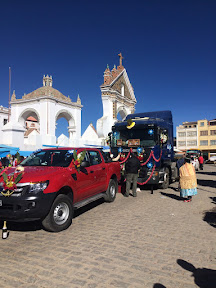Next stop was to Lago Titicaca, and from there we boarded a boat for Isla Del Sol, a really cool island on Lake Titicaca (which happens to be the biggest lake in South America and the highest navigable body of water in the world at 3812 m). The name comes from Quechua, the language of the indigenous people in the area (and the language the ancient Incans spoke). It means 'the Mount of the Puma.' Pottery has been found on the shores dating back to the mid-2nd millennium BCE, so people have called this place home for a very long time.

The stairs you are greeted with when you arrive at Isla Del Sol.

Jared making donkey friends

And I alpaca friends. In the shade, it was actually a little nipply. At this high altitude, we soon became accustomed to the Altiplano's extremes- really hot in the sunshine and freezing in the shade, worse at night!

Some fantastic views from the top of the island

And did I mention donkeys?! There were maybe more donkeys on this island than people. They were walking all over the island carrying cargo, braying, and carrying on.


A great spot for supper. There are freshwater trout here that have been introduced from Canada (sooorrrry). They kind of wreaked havoc on the endemic species, so you could feel good about eating them. Plus they were delicious.

Sunset on the lake


Great view from the window. Being cheapos, there are lots of nights we don't have the best view, but not tonight!

We were also lucky to catch some live music, this was a band from Argentina/Uruguay that played salsa/Cumbria/etc. Thanks for a great night Cucha Cucha!

Some pictures Jared took of the sunrise. I opted to stay in bed because I am naughty.

I was instead woken up by braying donkeys!


The view of the Cordillera mountains

Walking back down to the boats the next afternoon


Once back on the mainland, we took Gringa for a special treat- to be blessed by a priest! Here in Bolivia; rather than drive courteously and obey traffic laws, they just get their vehicles decked out in flowers and blessed by a priest. Then they are certain to have safe travels on the road. So we figured, if you can't beat them join them.

Here is Gringa decked out in her finery. Isn't she a beaut?!


And here we are with the Father. Notice the bucket of holy water, and camo hat. We're pretty sure he was a real priest.......

With Gringa safely blessed for Bolivian roads, we drove north. Our next adventure was the Rainbow Mountain, something we had seen on Instagram, oh, 340 times.

The drive out was awesome, very much the back-country.

Ausangate mountain in the distance

We wild-camped here for the night before starting the trek.

We started the next day, mid-morning. We tried to time it so as while we were climbing up the tourist hordes were climbing down, and it worked out perfect.



This was the zoo as we were walking up.....

But this was what we had at the top! Not a soul, magic!





We were so lucky to have this whole incredible place to ourselves. It was super challenging, climbing at 5000m is really no picnic, but luckily it was only a 3 hr hike.



The horse camp back at the base. Here they keep all the ponies that ferry the people up. Of course, Jared and I were waaaay too cheap and just walked up.

Mega alpaca party on the drive back down. There are SO many alpacas and llamas here. There are actually two types of alpacas here- Huacaya and Suri. The Huacaya are more teddy-bear looking and the Suri ones look like they have dreads.
My mom was coming to Cuzco in a few days, and we were getting very excited to see her. We still had a few days, though, so we headed to Paucartembo. This was a small town out in the country we had heard had a really crazy festival to honour the Virgen del Carmen.
Until Next Time!











































